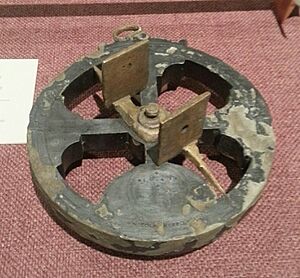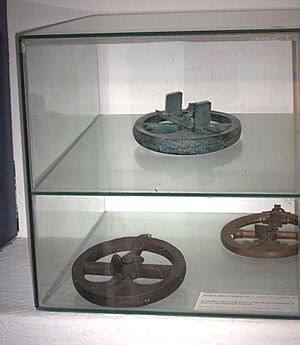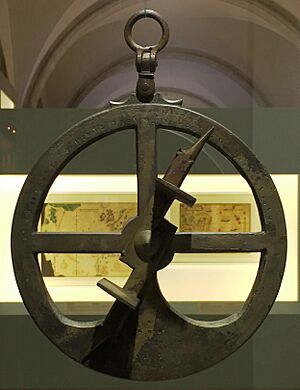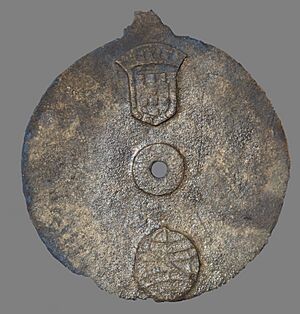Mariner's astrolabe facts for kids
The mariner's astrolabe was a special tool used by sailors long ago. It helped them figure out how far north or south their ship was at sea. They did this by measuring the height of the sun or a star in the sky.
This tool was not exactly like a regular astrolabe. Instead, it was a round metal circle with markings and a spinning arm called an alidade. Sailors used it to measure angles in the sky. It was built to work well on ships, even when the water was rough or winds were strong. The Portuguese, who were great sailors, invented this important instrument. In the 1500s, it was sometimes just called a "ring."
Contents
History of the Mariner's Astrolabe

People aren't exactly sure when the first mariner's astrolabe appeared. Some say it was as early as 1295, mentioned by an astronomer named Ramon Llull. Others believe it became known later, around the late 1400s.
What we do know is that Portuguese explorers helped create and improve this tool. The first clear instructions on how to build and use a sea astrolabe came from Martín Cortés de Albacar in his book Arte de Navegar in 1551.
The mariner's astrolabe likely came from the older, flat astrolabe. Early sea astrolabes even had some of the same markings. This new tool helped replace or work alongside other navigation tools like the cross staff or quadrant.
Sailors used the mariner's astrolabe until the late 1600s. After that, newer, more accurate tools like the Davis quadrant took its place. Much later, in the 1700s, the sextant became popular. Today, sailors use global positioning systems (GPS) to find their way.
Mariner's astrolabes are quite rare today, even though they were made of strong brass. In 2017, only 108 were known to exist. Many of them are in museums in Portugal. One famous example, from 1554, was found in a shipwreck called the San Esteban. It is now in a museum in Texas, USA.
In 2014, scientists found a very old disk-shaped astrolabe. It was on the wreck of a Portuguese ship called the Esmeralda, which sank in 1503 off the coast of Oman. This astrolabe, called the Sodré astrolabe, is now the oldest known. It might be a missing link between the older flat astrolabes and the open-wheel ones that came later.
How it was Built
Mariner's astrolabes were usually made from brass. Brass was good because it was heavy, which helped keep the tool steady on a rocking ship or in strong winds. Wood or ivory were not as good, though some wooden ones were made.
Early astrolabes were made from thin sheets of brass. But these were too light and didn't work well at sea. So, around the mid-1500s, people started making heavier ones from cast brass. The bigger the astrolabe, the more accurate it was.
Unlike the flat astrolabe, the mariner's astrolabe had an open, frame-like shape. This design allowed wind to pass through it, which made the tool move less in windy conditions.
The main part of the tool was a ring with degree markings. Early ones only had markings for 90 degrees, but later ones had a full 360-degree circle. The metal spokes inside the ring simply held the pivot point for the spinning arm. To make the tool even more stable, extra brass was often added to the bottom. This made the bottom heavier, helping it hang straight down.
The alidade, or spinning arm, could rotate freely around a pin in the center. It had small slots or holes that the user looked through to line up with the sun or a star. A ring at the top of the astrolabe allowed it to hang vertically.
How it was Used
To use the astrolabe, a navigator would hold it by the ring at the top. This made the tool hang straight up and down. The navigator would then turn the astrolabe to face the sun or a star.
Next, they would move the alidade (the spinning arm) until it pointed directly at the object. If it was a dim star, the navigator would look right through the alidade's holes. If it was the bright sun, it was safer to let the shadow of one of the alidade's vanes fall onto the opposite vane. Once aligned, the navigator would read the angle from the markings on the astrolabe.
This instrument was very important during the Age of Discovery, which Portugal started. Portuguese sailors taught others, like Christopher Columbus, how to use it. This knowledge helped other European countries explore and expand their empires across the seas.
Why it Had Limits
The mariner's astrolabe had to hang perfectly straight to measure angles. This meant it was hard to use on a ship's deck when it was windy. It also wasn't easy to measure the angle between two objects, which was needed for some navigation methods later on. Another problem was that its accuracy depended on the length of its spinning arm, which wasn't very long.
Because of these limits, better tools were developed over time.
See also





